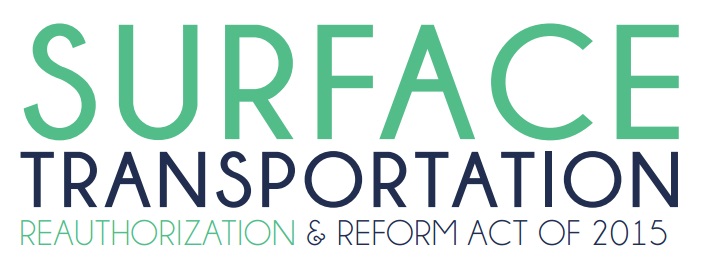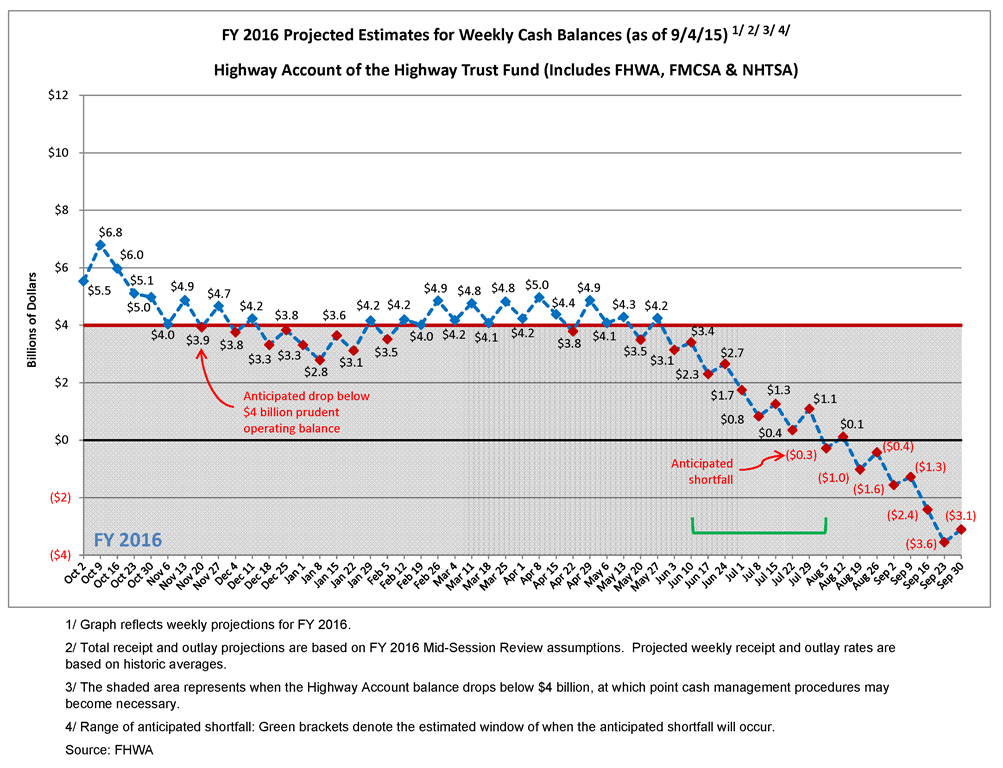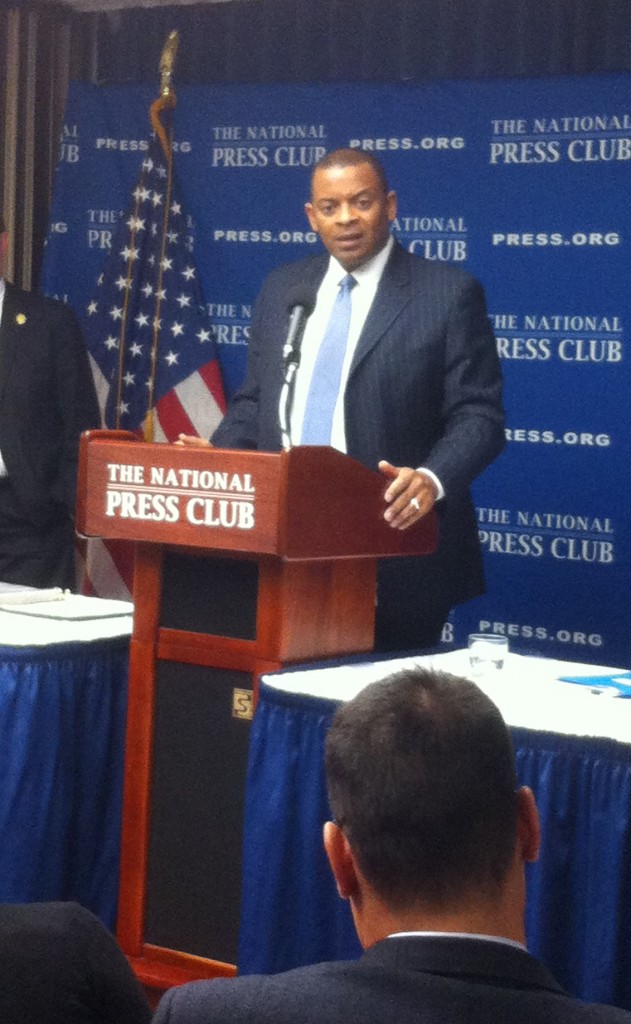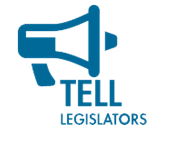House Readies for Action on Surface Transportation Bill
October 29th, 2015 | By: America's Infrastructure Report Card
 Yesterday, Congress enacted a short-term extension of current highway and transit program authority before the looming deadline of October 29. The current authorization and solvency of the federal Highway Trust Fund will now expire on November 20, which gives Congress about three more weeks to conclude a few important remaining steps in the process of completing work on a surface transportation bill:
Yesterday, Congress enacted a short-term extension of current highway and transit program authority before the looming deadline of October 29. The current authorization and solvency of the federal Highway Trust Fund will now expire on November 20, which gives Congress about three more weeks to conclude a few important remaining steps in the process of completing work on a surface transportation bill:
- Next week the House will take-up and likely pass its own six-year transportation bill which provides flat-line funding for the next three years;
- Immediately thereafter, the House and Senate will convene a conference committee and work quickly to produce a compromise bill;
- The House and Senate will then have to pass an identical bill through each chamber before it can be sent to President Obama for his signature, hopefully before the November 20 deadline.
House Unveils Surface Transportation Bill
October 19th, 2015 | By: America's Infrastructure Report Card
 On Friday, the U.S. House of Representatives’ Transportation & Infrastructure Committee unveiled a six-year surface transportation reauthorization bill. The bipartisan legislation, titled, the Surface Transportation Re-authorization and Reform Act (STRRA) of 2015, contains three years of flat-level funding for highway and transit programs and will be marked-up by the committee this Thursday. In rolling out their bill, legislative sponsors have stated the importance of its provisions to reform existing programs, refocus those programs on national priorities, provide more flexibility and certainty for state and local partners, and emphasis on transportation innovation.
ASCE believes that status quo funding levels for surface transportation, as is provided in STRRA, are inadequate. Currently this underinvestment costs the average American family about $1,000 from their budget each year from now until 2020 due to the current road, bridge and transit conditions. ASCE believes that members of the House should utilize every available opportunity to attempt to increase funding levels for highway and transit programs beyond where they currently exist in STRRA.
Despite the inadequate funding levels, STRRA does contain policy items that ASCE supports, including:
On Friday, the U.S. House of Representatives’ Transportation & Infrastructure Committee unveiled a six-year surface transportation reauthorization bill. The bipartisan legislation, titled, the Surface Transportation Re-authorization and Reform Act (STRRA) of 2015, contains three years of flat-level funding for highway and transit programs and will be marked-up by the committee this Thursday. In rolling out their bill, legislative sponsors have stated the importance of its provisions to reform existing programs, refocus those programs on national priorities, provide more flexibility and certainty for state and local partners, and emphasis on transportation innovation.
ASCE believes that status quo funding levels for surface transportation, as is provided in STRRA, are inadequate. Currently this underinvestment costs the average American family about $1,000 from their budget each year from now until 2020 due to the current road, bridge and transit conditions. ASCE believes that members of the House should utilize every available opportunity to attempt to increase funding levels for highway and transit programs beyond where they currently exist in STRRA.
Despite the inadequate funding levels, STRRA does contain policy items that ASCE supports, including:
- Multi-year program certainty that will help states and localities better plan and deliver projects;
- Accelerated project delivery reforms aimed to improve collaboration between agencies and create deadlines for agency action(s);
- Providing grants to states for continued and expanded pilot testing of future road user fee collection systems;
- A new competitive grant to address bus and bus facility needs;
- Increased focus on funding for roadway safety infrastructure and on the safety needs of rural roads; and
- An option for localities to bundle small projects such as bridges to increase efficiency.
It’s Off to the Races on a House Highway & Transit Bill
October 14th, 2015 | By: America's Infrastructure Report Card
Today, the chairman of the U.S. House of Representatives Committee on Transportation & Infrastructure (T&I) Bill Shuster (R-PA) announced that his committee would be holding a mark-up of a surface transportation authorization bill on October 22. The bill, text of which has not yet been finalized is titled, the Surface Transportation Reauthorization and Reform Act of 2015. In making the announcement, Shuster noted that the bill would, “reform programs, refocus those programs on national priorities, provide more flexibility and certainty for state and local partners, and welcome innovation.” The markup is set to begin at 10:00AM ET next Thursday and will be livestreamed here . The announcement comes after legislative progress this summer by the U.S. Senate which passed the DRIVE Act that provides three years of increased funding and six years of policy for federal road, bridge and transit programs. This funding increase is supported by a large majority of Americans as demonstrated in a recent public survey by the motor club AAA. The survey found that 70% of respondents believed that the federal government should invest more than it does now for roads, bridges and mass transit systems. The survey also found that only 38% of Americans believe that Congress is taking the necessary steps to ensure that our roads, bridges and transit systems will meet the needs of the nation.
Please let your House members know you support them moving forward quickly on legislation that provides multi-year certainty and increased funding levels for highway and transit programs.
The announcement comes after legislative progress this summer by the U.S. Senate which passed the DRIVE Act that provides three years of increased funding and six years of policy for federal road, bridge and transit programs. This funding increase is supported by a large majority of Americans as demonstrated in a recent public survey by the motor club AAA. The survey found that 70% of respondents believed that the federal government should invest more than it does now for roads, bridges and mass transit systems. The survey also found that only 38% of Americans believe that Congress is taking the necessary steps to ensure that our roads, bridges and transit systems will meet the needs of the nation.
Please let your House members know you support them moving forward quickly on legislation that provides multi-year certainty and increased funding levels for highway and transit programs.
New York Infrastructure Receives C- Report Card
September 29th, 2015 | By: America's Infrastructure Report Card
 In the inaugural 2015 Report Card for New York’s Infrastructure released today, the state received an overall grade of “C-” from the New York Council of the American Society of Civil Engineers. Assessing nine categories, the report finds that the state’s roads and bridges are among the categories most in need of repair, receiving grades of “D-” and “D+” respectively because of their state of deterioration and lack of adequate funding to improve conditions. In addition, wastewater received a low grade of “D.” The category of parks and solid waste both earned the highest grade of “B-.”
New York’s infrastructure faces several challenges and, in its current condition, the infrastructure system is a drag on the state’s economy. These challenges are highlighted in the Report Card:
In the inaugural 2015 Report Card for New York’s Infrastructure released today, the state received an overall grade of “C-” from the New York Council of the American Society of Civil Engineers. Assessing nine categories, the report finds that the state’s roads and bridges are among the categories most in need of repair, receiving grades of “D-” and “D+” respectively because of their state of deterioration and lack of adequate funding to improve conditions. In addition, wastewater received a low grade of “D.” The category of parks and solid waste both earned the highest grade of “B-.”
New York’s infrastructure faces several challenges and, in its current condition, the infrastructure system is a drag on the state’s economy. These challenges are highlighted in the Report Card:
- The three airports servicing New York City account for a majority of the nation’s airport delays. By the year 2030, JFK is expected to exceed its current traveler capacity by 30%, and ten other commercial service airports in New York will also exceed 60% of the current capacities.
- Of New York’s more than 17,000 bridges, the majority were built in the 20th century, with over 50% of bridges over 75 years old. Nationally, the average age of a bridge is 42 years.
- The average New York City area commuter, which accounts for half the state’s population, wastes 53 hours per year sitting in traffic.
- Poor road conditions and traffic congestion cost motorists a total of $6.3 billion statewide—an average of $477 per Syracuse motorists.
- The State of New York is only spending 20% of what is needed to modernize the wastewater system.
- One in every four of New York’s wastewater facilities are operating beyond their 30-year useful life expectancy.

- Create a prioritization program to assess the state’s transportation infrastructure needs starting from existing bridge asset management programs and based on accepted standards.
- Develop more consistent funding sources of funding for dams and support the creation of dam rehabilitation funding legislation at the federal and state levels for public and private owners of high hazard and intermediate hazard dams.
- As infrastructure is being rebuilt, make it more resilient and sustainable.
View the full report here.
Founded in 1852, the American Society of Civil Engineers represents more than 145,000 civil engineers worldwide and is America’s oldest national engineering society. ASCE’s 2013 Report Card for America’s Infrastructure, graded America’s cumulative GPA for infrastructure at a D+. The Report Card app for Apple and Android devices includes videos, interactive maps and info-graphics that tell the story behind the grades, as well as key facts for all 50 states.Highway Fund in Trouble by November 20th
September 23rd, 2015 | By: America's Infrastructure Report Card

GRAPH: Cash balance estimates of the Highway Account of the federal Highway Trust Fund; courtesy of the Federal Highway Administration
- October 29, which, following a July extension, is the new date to pass a renewal of the HTF authorization; and
- November 20, which is the projected date when federal funding will slow and be reduced to states.
Secretary Foxx to Congress: Raise Your Sights
September 9th, 2015 | By: America's Infrastructure Report Card

U.S. Department of Transportation Secretary Anthony Foxx speaks at the National Press Club; 9/9/15 – Photo by ASCE
Despite Senate Transportation Action, House Stymies Progress
July 30th, 2015 | By: America's Infrastructure Report Card
During the last two months, the Senate made good use of its time to craft a multi-year surface transportation bill with an increase in funding. As is often the way for Congress, it still came down to the wire. For over a week, the U.S. Senate has been in a mad dash to complete its work on a multi-year surface transportation bill before the looming July 31 legislative deadline hits. With the help of ASCE members, fellow coalition members including Associated General Contractors, the American Road and Transportation Builders Association, the U.S. Chamber of Commerce, many other groups, and the public, the Senate was successful in doing so – with even a little bit of time to spare. Today the Senate delivered to the House for consideration a six-year, $350 billion road, bridge and transit policy bill that provides three-years of dedicated funding and boosts current investment levels. The only problem? The House is not in session to take it up and pass it before the Friday deadline. In the Congressional equivalent of ding-dong-ditch, yesterday the House passed and sent to the Senate a three-month program extension just as House members left town for August recess, which meant the Senate had no option but to pass the three-month extension in order to avoid a program shutdown on July 31. So in the end the Senate was successful in doing its work, but was unable to get their effort signed into law by the July 31 deadline because the House left town early and refused to take it up. The Senate bill’s funding increases for highway and transit are a step in right direction, but still far below the investment levels America needs to address its aging roads, bridges, and transit systems. However, when compared to the horrible status-quo that the federal program finds itself in – a seemingly endless cycle of short-term extensions combined with a continued deterioration of the purchasing power of transportation dollars – the Senate bill was the most promising legislation proposed during the two-month extension. “In the next three months, ASCE urges the House and Senate to work through their policy differences and continue the legacy of the Highway Trust Fund,” said Tom Smith, ASCE’s executive director. “This short-term extension needs to be the last and we believe it can be, so long as Congress moves the nation forward by working together in a bipartisan way to finish their work on improving America’s surface transportation infrastructure.” Of note the Senate bill: • Provides six years of policy reforms and contract authority for highways and transit programs, thus ending the cycle of short-term, multi-month program extensions; • Provides three years of dedicated revenue to the Highway Trust Fund (HTF) so states can deliver more long-term projects; • Increases funding levels for both highway, transit and passenger rail programs in order to reduce our nation’s maintenance and construction backlog; • Provides for a new national dedicated freight program to improve goods movement; • Contains bipartisan permitting reforms that would set deadlines for project decisions, increase transparency and reduce litigation delays; and • Contains a federal pilot program for future user-fee revenue generating systems like those currently being tested in some states regarding vehicle miles traveled (VMT). While the summer legislative battle is over and victory was confined to the U.S. Senate, transportation advocates will take the August break and recharge our batteries to be ready for the final fall push when Congress is back in September. Please take a moment to see how your Senator voted and thank him/her on their leadership this July. We will need their support again soon enough once a final House and Senate compromise comes together.Five (More) Myths About the Highway Trust Fund
July 15th, 2015 | By: Becky Moylan
1. Devolving the federal program to the states is a viable option Devolution is the idea of eliminating the federal government’s ability to collect the current 18.4 cents per gallon in federal gasoline taxes (absent a few cents to remain dedicated toward maintaining the Interstate Highway System) and transferring all authority over these programs to the state. This act would represent one of the single greatest unfunded mandates at nearly $50 billion—a violation of the Unfunded Mandates Reform Act of 1995. The current system empowers states by making the federal role a reimbursement process, allowing states to make their own planning and building decisions while also having some overall coordination and safety standards among states. Many states have raised their own gas taxes recently, essentially catching up the purchasing power of their current gas tax rates with inflation since they were last adjusted. For example, Iowa had not raised its gas tax since 1989 and its 10-cent increase was a hard fought battle. To ask states to pick up the tab for the federal role—which on average is 52% of the state’s capital budget each year—would be a huge burden to states’ budgets. On average, states would need to raise their gas tax by 23 cents or significantly cut their transportation program. It would not be the easy task that the proponents of devolution make it out to be. Instead, our roads, bridges and transit would continue to deteriorate and the backlog of projects would grow longer and the system will become patchwork if some states fail to make investments. 2. Transportation has become a partisan issue Transportation has historically been a bipartisan issue, and passing a multi-year, properly funded transportation bill will only be accomplished through bipartisan cooperation. In the past year, there have been several bipartisan proposals to help address the Highway Trust Fund crisis. Senators Bob Corker (R-TN) and Tom Carper (D-DE) have proposed a plan. In the House, Reps. Renacci (R-OH), Pascrell (D-NJ), Ribble (R-WI), and Lipinski (D-IL) have introduced the Bridge to Sustainable Infrastructure Act. Before the Independence Day Recess, the Senate Committee on Environment & Public Works unanimously passed the DRIVE Act out of committee. Both sides of the aisle acknowledge that our transportation system is ailing and that something must be done. Fixing the Highway Trust Fund is, at its heart, a bipartisan endeavor. 3. Flat funding is fine If Congress does not grow the program and increase federal funding levels in the next multiyear transportation bill, then our economy will continue to suffer. In 2011, ASCE released an economic study on transportation titled Failure to Act, which details how underinvesting in transportation is a drag on our economy. The study outlined what the economic ramifications will be by 2020 if status quo funding levels continue. Among them, we revealed that America’s GDP will underperform by $897 billion in total by 2020 and each family’s budget loses $1,060 each year in disposable income—money every American household has already lost and will continue to lose if we don’t improve our transportation network. Underinvestment in transportation will cost our economy 877,000 jobs in the year 2020. Continuing to fund at current levels for the next several years will neither improve our aging transportation network, nor grow the economy 4. A gas tax is not politically possible Several states have recently acted in bipartisan fashion to pass gas tax increases. In those states, 90% of those who voted in favor the gas tax increase got reelected in the following election. And many were conservative states, like Arkansas, which needed to see a high return on investment. A poll by the Mineta Transportation Institute demonstrated that people are willing to pay more in gas taxes if it goes to improving transportation. This study shows that voters recognize the connection between potholed roads and aging bridges and underinvestment. In addition, the impact of a gas tax on gas prices is not as direct as sometimes thought. A recent study by ARTBA finds that gas tax increases have very little impact on the overall price of a gallon of gas. CBO projects that the Highway Trust fund’ revenue shortfall will be $8 billion at the end of this year and be between $85 billion and $90 billion by May 31, 2021. There is no reason to add to the national debt and our burden on future generations when raising the gas tax is a deficit-neutral options. 5. We can kick the can again Two-month stopgaps hurt the economy and American business. For two consecutive years, the summer highway and transit construction season has taken a hit because of the uncertainty surrounding the federal program. For example, just in the last few weeks and months, several states have announced they are canceling or delaying projects until Congress passes a multi-year bill. These short-term extensions not only delay existing projects in the pipeline but prevent major projects from being considered in light of the lack of a clear federal funding commitment. Ultimately the lack of certainty hinders our nation’s ability to dream big on ways to modernize our infrastructure and create the foundation for the 21st century economy. See the original posts 10 Myths About the Highway Trust Fund.Gas Tax Gets New Attention
July 10th, 2015 | By: Olivia Wolfertz
The hour glass is running thinner on the federal surface transportation program. Congress has only three weeks left to pass a robust, multiyear surface transportation bill before the self-imposed deadline. This week ASCE joined with the American Road and Transportation Builders Association in sponsoring an ad directed at Congress and the President, asking that they continue the legacy of federal investment in transportation. One Congressman introduced legislation this week that could be an answer to that call. Republican Rep. Tom Rice’s legislation, “The Highway Trust Fund Certainty Act,” would raise the federal gas tax by 10.1 cents-per-gallon and index the rate to inflation. This rate would increase Trust Fund revenues by $17 billion—addressing the current funding shortfall and allowing slight growth to the program. In a letter to the Congressman, ASCE commended Rep. Rice’s leadership on this issue, but noted that additional federal investment will still be required to meet our nation’s long-term surface transportation infrastructure needs. Another gas tax increase proposal, the UPDATE Act, also continues to gain supporters and now has 35 co-sponsors. Meanwhile, Transportation Secretary Anthony Foxx is urging Congress to step up and pass a long-term highway funding bill. “We’ve got some problems. I would label it a crisis — a legitimate, disturbing and alarming crisis in our infrastructure system,” Foxx told a small group of reporters at the department’s headquarters Wednesday. He also warned that the administration will begin to notify states about the threat to their transportation funding if Congress doesn’t pass a long-term extension soon. States like Alabama, Massachusetts, Montana, New Hampshire, South Dakota, Missouri and more are publicly acknowledging their dire infrastructure needs and have begun to halt construction due to the uncertainty of federal funding. With three weeks left, it’s important that your Members of Congress hear from you about why they must work together to come up with a long-term funding solution before July 31 in order to #FixTheTrustFund. Write a letter, call you Senators’ and Representative’s offices, and tweet using #FixTheTrustFund to remind your representation in Washington they have a job to do and a deadline fast approaching.#FIXTHETRUSTFUND This Week: Time for Congress’ Next Move
July 6th, 2015 | By: Becky Moylan
 Congress returns to D.C. this week, and we’re watching the Senate (where the most promising legislation was recently passed through the EPW Committee) to see if the Senate Commerce Committee or the Senate Banking Committee will start to mark-up their portions of the highway and transit bill. However to truly move forward, Senate leadership and the Senate Finance Committee need to find the revenue to move the DRIVE Act forward.
With just 16 working days with both chambers in session before the July 31 deadline, it’s important that Congress hear from you. Drive Congress to #FixTheTrustFund in the following ways:
Congress returns to D.C. this week, and we’re watching the Senate (where the most promising legislation was recently passed through the EPW Committee) to see if the Senate Commerce Committee or the Senate Banking Committee will start to mark-up their portions of the highway and transit bill. However to truly move forward, Senate leadership and the Senate Finance Committee need to find the revenue to move the DRIVE Act forward.
With just 16 working days with both chambers in session before the July 31 deadline, it’s important that Congress hear from you. Drive Congress to #FixTheTrustFund in the following ways:






 */ ?>
*/ ?>














